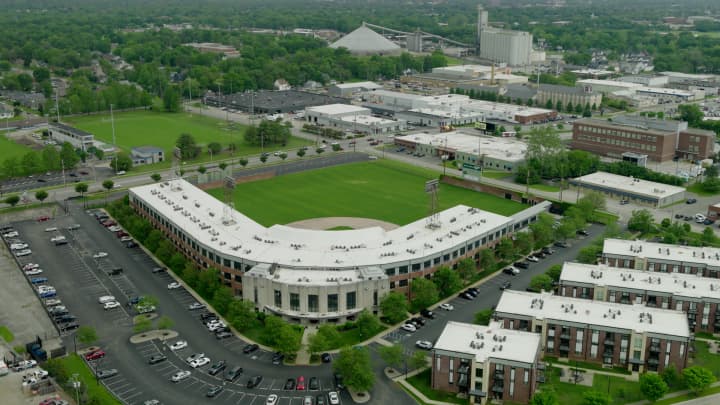The transformation of the former “Indianapolis Indians baseball stadium” into Stadium Lofts, a 138-unit apartment complex, represents a remarkable fusion of urban redevelopment and preservation. What started as a seemingly wild idea by developer Michael Cox turned into one of the most unique residential properties in Indianapolis. The project, completed after a $14 million renovation, underscores the growing trend of adaptive reuse—repurposing abandoned or underused spaces for new functions—while preserving the historical and cultural heritage of a city. Cox’s vision, executed in partnership with John Watson and his two sons, not only saved a beloved landmark but also brought it back to life as a bustling residential community.
The Case for Adaptive Reuse in Urban Development
The Stadium Lofts project is a prime example of “adaptive reuse”, a strategy that is becoming increasingly popular in urban development. Rather than demolishing old structures and replacing them with new ones, adaptive reuse seeks to preserve the history and character of a building by transforming it into something new. In the case of Stadium Lofts, the former Bush Stadium, which had been home to the “Indianapolis Indians” from 1931 to 1996, was on the verge of being torn down after years of disuse and decay. However, Cox saw potential in the dilapidated structure and, with the help of the city, was able to acquire the property for just $1.
The decision to invest in a project like this is not without risks. Adaptive reuse projects often come with significant challenges, including structural issues, zoning complications, and the high cost of renovations. Yet, they also offer substantial rewards, both economically and culturally. By repurposing existing buildings, developers can reduce the environmental impact of new construction, preserve local history, and often create something truly unique that stands out in the crowded real estate market. In this case, Cox and Watson’s decision to maintain the integrity of the stadium’s original features, such as the “scoreboard, ticket booths, and press box”, while also updating the building for modern residential use, demonstrates how adaptive reuse can be both a preservationist and forward-thinking approach to development.
Preserving History: Honoring the Legacy of Bush Stadium
One of the most striking aspects of the Stadium Lofts project is how the developers managed to preserve the historical essence of Bush Stadium. For many residents of Indianapolis, the stadium was a beloved landmark, holding decades of memories as the home of the Indianapolis Indians. By the time Cox began his renovation project in 2011, the stadium had been out of use for nearly two decades and had become little more than a shell of its former self. Many thought that demolishing the structure was the only viable option. However, Cox had a different vision—one that involved not only saving the stadium but also giving it new life as a residential complex.
From the outset, the developers made a conscious decision to retain several key features of the old ballpark. The original scoreboard still stands as a reminder of the stadium’s past, and the bases were even reinstalled on the field, preserving the spirit of the baseball diamond. The “old ticket booths and press box” remain intact, incorporated into the new design in a way that allows them to serve as functional elements of the apartment complex while also standing as historical markers. Watson, Cox’s partner, explained that the goal was to create a space where “when you walked in, you felt like you were walking into a historic stadium rather than an apartment building.” This sentiment clearly resonated with potential tenants, as all 138 apartments were leased by the time the project was completed in July 2013.
The combination of old and new is a delicate balance that few developers manage to achieve. In this case, Cox and his team were able to create a modern, functional living space while preserving the unique history of the site. For residents of Stadium Lofts, living in a building with such a rich historical background adds an additional layer of value to the property, making it more than just another apartment complex.
Impression
The economic impact of the Stadium Lofts project cannot be understated. The “$14 million renovation” not only revitalized a once-abandoned part of the city but also contributed to the broader economic development of the area. The project brought new residents into a part of town that had been largely overlooked, helping to stimulate local businesses and services. The rental prices at Stadium Lofts, which range from $900 to $1,700, are competitive for the area, providing a range of options for potential tenants from different income brackets.
Moreover, the success of Stadium Lofts demonstrates how adaptive reuse can serve as a model for other cities facing the challenge of what to do with aging or abandoned structures. Rather than demolishing such buildings, developers can explore creative ways to repurpose them, preserving the historical and cultural significance of the site while contributing to the local economy. This is especially important in cities like Indianapolis, where industrial decline has left many areas in need of revitalization. Projects like Stadium Lofts offer a way forward, showing how developers can breathe new life into neglected spaces.
Socially, the project has also had a positive impact. The unique nature of the apartment complex has created a sense of community among residents, many of whom are drawn to the building because of its historical significance. The careful attention to preserving the original features of the stadium has given residents a sense of connection to the past, creating a shared identity among those living in the complex. In this way, Stadium Lofts is more than just a place to live—it’s a community space that fosters a sense of belonging and pride.
Challenges and Future Implications
While the Stadium Lofts project has been a success, it was not without its challenges. The decision to preserve so many elements of the original stadium added complexity to the renovation, and the costs of adaptive reuse can often be higher than new construction. In this case, Cox and Watson were able to secure the stadium for just $1, but other developers may not be so lucky when it comes to acquiring old buildings for a similarly low price. Additionally, adaptive reuse projects can face significant regulatory hurdles, especially when it comes to zoning and building codes. In some cases, existing structures may not meet modern safety standards, requiring costly updates.
Despite these challenges, the success of Stadium Lofts offers an important lesson for future developments: with creativity, vision, and determination, developers can turn abandoned or underutilized spaces into vibrant, thriving communities. The project demonstrates that historic preservation and modern development need not be mutually exclusive, and that with careful planning, the two can complement each other in ways that benefit both the local community and the broader city.
No comments yet.







